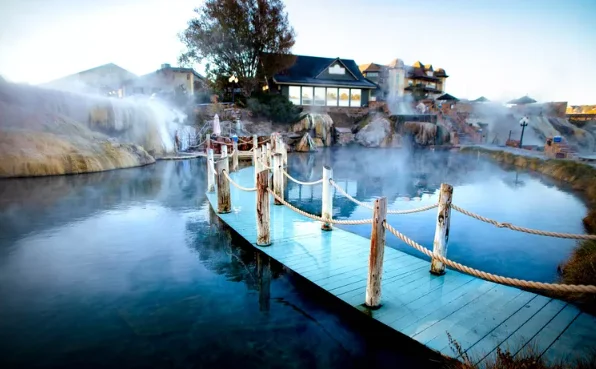Natural hot springs have been appreciated for centuries, providing a location to de-stress and rejuvenate. These geothermal pools, heated by the Earth’s core, provide warm, mineral-rich water. Many believe soaking in them can help ease muscle tension and promote relaxation. Across different cultures, these springs have been used for rest and recovery, making them a valued part of traditional wellness practices.
In various parts of the world, hot springs attract visitors looking for a natural relaxing way. For example, the thermal baths in Iceland are well-known for their warm waters and unique surroundings. People soak in these pools not just for comfort but also for the experience of being in nature. Whether located in remote mountains or near active volcanic areas, these springs provide many with rest and relief.
The Science Behind Hot Springs
The geothermal activities taking place beneath the Earth’s surface produce natural wonders called hot springs. These warm waters are rich in minerals like sulfur, magnesium, calcium, and potassium, all essential for human health. As these minerals ascend to the surface, they form comforting thermal baths that encourage relaxation and recovery.
These minerals are not just the result of volcanic activity; they also play a significant role in improving physical well-being. Sulfur is recognized for its ability to detoxify, while magnesium aids in promoting muscle relaxation and a sense of calm. Calcium is essential for sustaining strong bones and boosting heart health. Focusing on these minerals can bring various health advantages, such as detoxification, improved skin condition, and decreased inflammation in muscles and joints.
The restorative effects of hot springs have contributed to the growing popularity of heat therapy and hydrotherapy practices, which use warm, mineral-rich water to support physical well-being and relaxation.
Global Hot Spot Highlights
Hot springs are scattered worldwide, each locale offering its unique form of allure. The well-known Blue Lagoon in Iceland, with its iconic azure waters and the surrounding stark black lava fields, offers a spa experience that is both a visual and sensory delight. Meanwhile, Turkey’s Pamukkale dazzles with white travertine terraces, cascading thermal waters, and a history that spans centuries. In Japan, the traditional onsens are more than just bathing places; they are integral to spiritual and physical wellness, appreciated for their peaceful ambiance, and deeply embedded into the cultural psyche. Each destination carries its legends, traditions, and geological beauty, proving that no two hot springs are alike.
Health and Wellness Benefits
The vibrancy of hot springs extends beyond their captivating visual appeal and rich cultural significance; it is rooted in profound physical properties. These naturally occurring mineral-rich waters are teeming with beneficial elements such as magnesium, sulfur, and calcium, each contributing to a wide range of wellness benefits that contemporary science increasingly validates. Regular soaks in hot springs are celebrated for their ability to stimulate blood circulation, which can significantly alleviate symptoms of arthritis and joint pain while also enhancing overall muscle relaxation and flexibility.
Alongside their physical benefits, hot springs serve as havens of mental relief, creating a tranquil atmosphere that reduces stress and anxiety. The warm water’s calming effects and tranquil surroundings promote mindfulness and peace. This unique fusion of mental and physical well-being solidifies hot springs as a favored destination for travelers who seek holistic health benefits, all amid the breathtaking beauty of nature. Whether enjoying the soothing warmth of the water or the picturesque landscapes surrounding them, visitors often leave feeling rejuvenated and refreshed, both body and mind.
Cultural Significance and Traditions
The cultural tapestry surrounding hot springs is as rich and varied as the minerals they contain. In numerous Indigenous beliefs, hot springs are considered sacred spaces, abundant in healing energy and spiritual cleansing. From the Japanese onsens, where customs strictly govern etiquette and seasonal usage, to the rich stories of miraculous healings associated with numerous springs worldwide, these naturally heated pools are much more than tourist spots—they are custodians of ancient traditions and stories. This cultural depth enhances the appeal of hot springs, inviting not just tourists but seekers of authentic cultural experiences and connections to the Earth.
Safety First: Guidelines for Enjoying Hot Springs
Hot springs offer a unique and rewarding experience but must be approached with safety in mind. Some hot springs may exceed temperatures of 140°F (60°C), causing severe burns and potentially containing harmful bacteria like Legionella. Visitors should follow posted guidelines, such as temperature limits, designated bathing areas, and local park services or guides. While many sites provide facilities, it’s the responsibility of each individual to respect nature’s power and recognize its limits. Adhering to environmental conservation guidelines is crucial for protecting and preserving the delicate ecosystems surrounding hot springs. This includes staying on designated paths, avoiding soaps or shampoos in natural waters, and disposing of waste properly. By practicing sustainable behaviors, visitors can help preserve these beautiful geological features for future generations.
Eco-Tourism and Sustainable Practices
As the popularity of hot springs burgeons, so does the imperative for sustainable tourism practices. Overcrowding can severely impact the delicate balance of these environments, leading to issues like erosion, water contamination, and habitat disruption. Guests are urged to adopt environmentally conscious behaviors, like steering clear of soaps or shampoos that might change the water’s chemistry and to respect local flora and fauna. Supporting and engaging with local conservation projects helps ensure these geothermal features can sustain their beauty and benefits over time, securing them as natural sanctuaries to be enjoyed by future generations.
Conclusion
Hot springs offer an extraordinary fusion of natural beauty, cultural richness, and restorative health benefits. From Iceland’s icy landscapes to Turkey’s sun-drenched terraces, they draw individuals worldwide with their promise of warmth and healing. Yet, as stewards of the Earth, it is our responsibility to enjoy these wonders conscientiously and sustainably. By respecting cultural traditions and embracing eco-friendly practices, we ensure that hot springs remain vibrant and accessible to warmth, tranquility, and health. These therapeutic wonders can continue inspiring and healing through mindful engagement, maintaining their allure for generations.

Melody Roth, a seasoned blog writer with a passion for the delectable world of food, specializes in crafting mouth-watering articles on favorites like pizza and burgers. With years of experience under her belt, Melody serves up stories as tantalizing as the dishes she describes, making her an invaluable voice in the culinary blogging realm.

